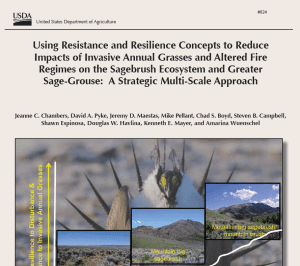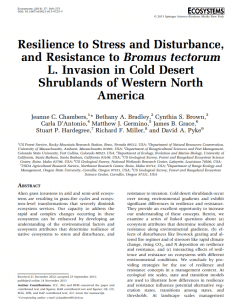Invasive Species
View report.
This final report includes actions to be implemented by Interior’s bureaus to immediately address the threat of rangeland fire and other disturbances to Western sagebrush-steppe landscapes and improve fire and fuels management efforts.
View abstracts.
These abstracts of recent papers on range management in the West were prepared by Charlie Clements, Rangeland Scientist, USDA Agricultural Research Service, Reno, NV.
View article.
In this news article, work by Ann Kennedy, scientist at Washington State, Susan Meyer, USFS research ecologist, and others is highlighted. Their work includes sorting through some 20,000 strains of naturally occurring soil bacteria to discover two that single out cheatgrass.
View report.
This report provides a strategic approach for conservation of sagebrush ecosystems and greater sage-grouse that focuses specifically on habitat threats caused by invasive annual grasses and altered fire regimes. It uses information on (1) factors that influence sagebrush ecosystem resilience to disturbance and resistance to invasive annual grasses and (2) distribution, relative abundance, and persistence of sage-grouse populations to develop management strategies at both landscape and site scales.
View research brief.
This research brief highlights a study investigating whether on not deer mice could help combat the invasive weeds infiltrating desert landscapes after fire.
View synthesis.
This synthesis describes what is known about the cumulative impacts of historic livestock grazing patterns and short-term effects of livestock grazing on fuels and fire in sagebrush ecosystems. Over years and decades grazing can alter fuel characteristics of ecosystems. On a yearly basis, grazing can reduce the amount and alter the continuity of fine fuels, potentially changing wildlife fire spread and intensity. However, how grazing-induced fuel alterations affect wildland fire depends on weather conditions and plant community characteristics. As weather conditions become extreme, the influence of grazing on fire behavior is limited, especially in communities dominated by woody plants.
View synthesis.
This review of the literature found that in general long-term rest and modern properly managed grazing produce few significant differences. However, some topic areas have not been adequately studied to accurately predict the influence of long-term rest compared to managed grazing. In some situations, not grazing can cause an accumulation of fine fuels that increase fire risk and severity and, subsequently, the probability of sagebrush steppe rangelands converting to exotic annual grasslands. Shifts in plant communities (i.e., exotic annual grass invasion and western juniper encroachment), caused in part from historical improper grazing, cannot be reversed by long-term rest.
View article.
This study found that growth rate of cheatgrass increased in both warming and snowmelt treatments. Largest increases occurred in warming plots during the wettest year, indicating that the magnitude of response to warming depends on moisture availability. Results indicate that increasing temperature will exacerbate cheatgrass impacts, especially where warming causes large reductions in the depth and duration of snow cover.
View review.
This review examines the effects of disturbances, such as grazing, and changes in climate on resilience and resistance of cold desert shrublands that span temperature and precipitation gradients across the western United States. It demonstrates how to use information about cold desert resilience and resistance to help manage this ecosystem and describes the benefits of using protection, prevention, restoration, and monitoring strategies to determine priority management areas and appropriate management actions.
View brief.
This brief evaluates the potential effects of Diorhabda herbivory on tamarisk fire behavior at Great Basin and a Mojave Desert sites.



